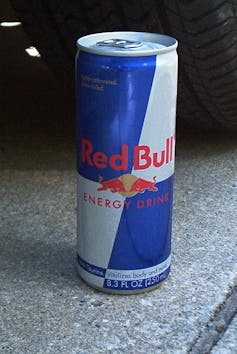When a 17-year-old girl, with a potentially life-threatening heart disorder, recently presented to me with an abnormally fast and irregular heart rhythm, I wondered how the natural history of her disease could so abruptly lead to a potentially fatal electrical rhythm disturbance.
Until I questioned her more about the moments leading to the rhythm problem.
Uncharacteristically, she had consumed a significant volume of a popular energy drink. Within an hour, she was in hospital receiving electrical shocks to her heart to bring it back to a normal rhythm. A mere coincidence, or did consuming an “energy drink” trigger her potentially fatal heart rhythm?
Energy drink consumption has grown exponentially over the past five to ten years. Sales are increasing at double the rate of total carbonated beverage sales.
The drinks are primarily targeted at the vulnerable youth and young adult market with aggressive advertising and marketing. And the potential medical complications of ingesting such drinks are becoming apparent, to both cardiologists and other health specialists.
So what is in energy drinks that could potentially trigger cardiac events? These drinks typically comprise of high levels of caffeine, guarana, taurine and sugar, with various other amino acids often also included. Indeed, at the time of this article being published, there’s no regulation on ingredients included in energy drinks in Australia or the United States.
The combined levels of caffeine in these energy drinks are much higher than a standard cup of coffee. And adverse events and complications from energy drinks largely arise from their caffeine content.
What’s more, energy drinks are intended to be drunk fast, and more recently, have been condensed to smaller volumes – so-called “energy shots”. These are freely available in petrol stations and other convenience stores.

So what are the medical effects of energy drinks? Based on currently available peer-reviewed scientific literature, there are many. From a cardiac perspective, there are three main effects: an increase in heart rate, an increase in blood pressure, and evidence of increasing blood viscosity that can lead to clots forming in the heart and beyond.
Most recently, three independent cases have been described in the medical literature where consumption of energy drinks led to catastrophic consequences, including cardiac rhythm disturbances and cardiac arrest.
Many other, non-cardiac effects of energy drinks have been reported, including anxiety, insomnia, vomiting, nervousness and irritability. As well as this, many young adults combine high-energy drinks with alcohol or physical activity, which can further exacerbate the potential risks of active ingredients.
The three recent cases highlight the potential detrimental cardiac effects of energy drink consumption, particularly in those who may be predisposed to arrhythmias because of underlying genetic heart disease.
Given the potential catastrophic consequences of energy drink consumption among susceptible young individuals, greater community education and awareness needs to be promoted.
This may include somewhat more drastic measures, including more graphic and clear warnings on energy drink cans to convey the potential dangers, much like the highly successful packaging of cigarettes, which include images of the consequences of smoking such as cancer. Another key initiative may be to restrict the sales of energy drinks to children and adolescents, often the target of energy drink advertising and under significant peer influence.
The collective goal of such measures is to prevent the incidence of potentially life-threatening cardiac rhythm problems, particularly in the young, by raising awareness in the community of the potential detrimental effects of energy drinks.

